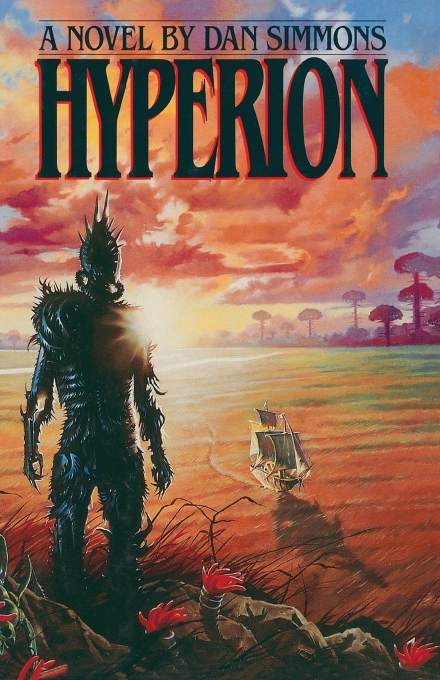Dan Simmons’s
Hyperion

I’m going to open here by repeating the sentiments of another of this novel’s reviewers: I don’t know how on Earth I have missed reading this purely astonishing novel for all of these years.
It’s been around since 1989 and I’ve picked it up several times; but I’m not always in the mood for ‘hard’ science-fiction and my last big encounter hardly had me rushing off to read more. (Peter F. Hamilton’s The Reality Dysfunction, since you asked — and reviewed on this blog.)
Hyperion, however, is something quite different altogether. Yes, it is of the hard variety, is a sprawling great space-opera and there is a ton of technology to get your head around; but it is also first and foremost character-driven – and what characters!
On the surface, each of the seven main protagonists sounds like a stereotype of the most unimaginative kind. For example, we have the Catholic priest who has had a crisis of Faith; there is the hard-boiled private detective; and, of course, where would we be without the alcoholic poet?
Yet once each of them begins their story – and those stories are riveting! – we are treated to layer after layer of growing complexity.
Simmons deals in poetic/literary metaphors throughout, in particular with the increasingly important references to English poet John Keats. Sometimes what he is getting at is obvious, sometimes quite hidden. And it’s not necessary that you get them all, although it will deepen your enjoyment as well as augment your admiration for this monumental achievement by the author. So it’s no surprise that he openly adopts the structure of Chaucer’s Canterbury Tales, with each of the characters being given his chance to tell us their story.
In the initial one (The Priest’s Tale: ‘The Man Who Cried God’), the eponymous priest has been disgraced for attempting to falsify evidence of a Christian society that predated Christ on Earth. Then, whilst in exile on the mysterious planet of Hyperion – and giving the title a nice sense of irony shared by all the tales – he then stumbles across what seems to actually be genuine evidence of a pre-Christ Christ.
(In one of those odd little examples of synchronicity, I was reading this in the same week that I came across what was to me a new word: xenoarchaeology. If you haven’t guessed what it means, look it up, ye lazy sods.)
And if you think that your mind couldn’t be more blown after that, the secret to what is taking place will make a liar of you. Frankly, I was so enthralled that I didn’t think it could possibly get any better after this; but it does, dear reader, it does!
In at the Deep End
As Steven Erikson did with his Gardens of the Moon, Dan Simmons begins this massive novel pretty much in the middle, with this initially daunting opening paragraph:
“The Hegemony Consul sat on the balcony of his ebony spaceship and played Rachmaninov’s Prelude in C-sharp Minor on an ancient but well-maintained Steinway while great, green, saurian things surged and bellowed in the swamps below. A thunderstorm was brewing to the north. Bruise-black clouds silhouetted a forest for giant gymnosperms while stratocumulus towered nine kilometers high in a violent sky. Lightning ripped along the horizon. Closer to the ship, occasional vague, reptilian shapes would blunder into the interdiction field, cry out, and then crash away through indigo mists…”
I took a deep breath, put down the book, put on the Rachmaninov, picked the book up again and never looked back.
Each story takes us back a little and feeds us some more information on events – and as the bits all began to fit together, I marveled at this remarkable fusion of mystery, hardcore action novel, spiritual quest, anti-colonialist diatribe…there is just so much here.
With each story, you will hate and shudder at some of the environments that Simmons paints; or with The Consul’s Tale: ‘Remembering Siri’, you might just decide you want to move there.
And as each tale proceeds, we get closer and closer to just one of the mysteries at the core of the planet Hyperion: what is the strange creature known as The Shrike which links each tale and is the guardian of the mysterious artifacts known as the Time Tombs – and when they complete their journey backwards in Time what are they destined to reveal to us?
This is one of the best science-fiction novels I have ever read. Yes, it actually does deserve its regular place on the Best Lists. It is a thing of horror and beauty and… that word again: mystery.
Even though it ends on a cliffhanger – a totally satisfying cliffhanger, I hasten to add, with a very unexpected literary reference – I was tempted, sad person that I am, to simply start the book again.
However, as it goes straight into an immediate sequel, I doubt that I have the willpower to wait.

Dan Simmons Author

Recent Comments